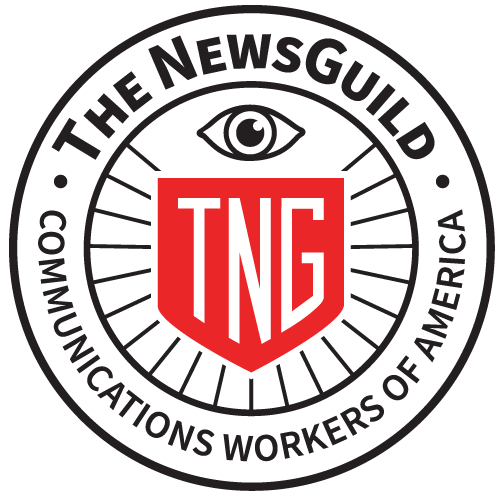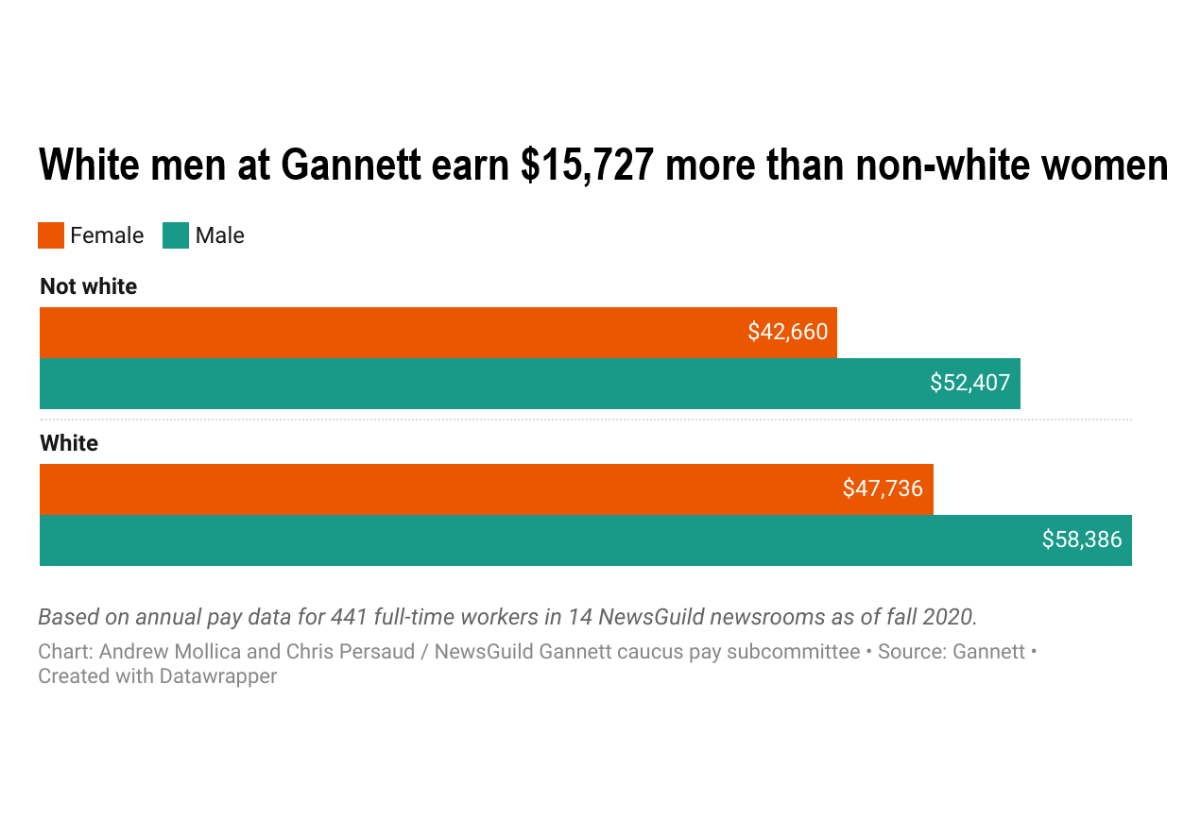More than two dozen Gannett journalists share personal testimonials in the report.
Contact:
Rebekah Sanders, Arizona Republic Guild Chair
480-242-3096, Rebekah.L.Sanders@gmail.com
A first-of-its-kind pay equity study of 14 Gannett newsrooms by NewsGuild members sheds light on stark pay disparities for women and journalists of color and a workforce whiter than the communities they cover.
The study of nearly 450 employees also shows that unions make a difference. Unionized newsrooms with pay scales in their contracts had significantly smaller gender and racial pay gaps than newly organized units with no contracts yet in place.
Key findings:
- Women who worked at least 30 years at newspapers currently owned by Gannett earned $27,026 less, or 63% the annual median salary of male peers.
- Women of color earned $15,726 less, or 73% of white men’s median salary.
- Women earned $9,845 less, or 83% of men’s median salary.
- Women 50-60 years old earned $6,642 less, or 90% the median salary of men in the same age range. The gap grew to $10,677 when including part-timers.
- Journalists of color earned $5,246 less, or 90% of the white median salary.
- Experienced female journalists and journalists of color were rare. Men outnumbered women age 30 and above, or with at least 10 years at the company, by about 2 to 1. White journalists outnumbered journalists of color age 40 and above, or with at least 10 years of service, by more than 4 to 1.
- Thirteen of 14 newsrooms were whiter than the communities they covered. Only the Knoxville News Sentinel was more diverse than its county.
- The Arizona Republic was the most diverse newsroom but had the largest gender and racial pay gaps. Women made nearly $30,000 less in median wages than men. People of color earned about $25,000 less in median wages than white employees.
- Unionizing improves pay equity. Newsrooms with union contracts had a gender pay gap that was $6,846 smaller and a racial pay gap that was $5,443 smaller than newsrooms currently negotiating first contracts.
Members of the NewsGuild, an international union of journalists, have led the way in calling for fair pay in the media industry.
But this is the first time, we believe, a pay equity study has been released for multiple units across a newspaper chain. By combining data, small newsrooms that would not have been able to conduct pay studies on their own were able to participate.
“I want to see more people of color and more experienced women of color in leadership roles at Gannett. More needs to be done to retain us and promote us. We need to pay fair wages and mentor journalists of color with purpose to retain them and inspire young journalists. This report shows Gannett has a lot of work to do.”
— Natalia Contreras, reporter for the Indianapolis Star and president of the Indianapolis NewsGuild (TNG-CWA Local 34070).
“We participated in this study because open conversations about pay help everyone. This report shows that the company cannot write off the concerns that women and journalists of color have about pay inequity. If Gannett truly wants to support diverse newsrooms, there is no other place to start than making sure people are fairly compensated.”
— Devi Shastri, reporter for the Milwaukee Journal Sentinel and president of the Milwaukee Newspaper Guild (TNG-CWA Local 51).
“Data journalists from across Gannett collaborated on this 9-month project. We gave the pay equity report as much care and consideration as we do our deepest, award-winning journalism to ensure its accuracy and impact.”
— Justin Price, data reporter for The Arizona Republic and member of the Arizona Republic Guild (TNG-CWA Local 39213).
Gannett pledges diversity, but doesn’t back it up with pay
Gannett pledged in 2020 to hire and promote more women and employees of color to reflect national and local demographics in the workforce.
In 2021, a company report found Gannett’s executive team was 84% white and 73% male, while its newsrooms were 58% male and 79% white. (Similarly, our study of 14 newsrooms found 59% of employees were male and 78% were white.)
The company announced “inclusion, diversity and equity are core to our business,” and all employees should have “equal opportunities to thrive.”
“(W)e are committed to … driving positive change. While this will, at times, mean addressing and combating systemic barriers and having uncomfortable conversations, we believe silence is not an option. We want to … become a leader not just in what we do, but who we are as a company,” CEO Mike Reed said in the 2021 report.
However, neither report promised to ensure fair pay or correct pay gaps, key parts of attracting and retaining talent. And though the company touted its commitment to transparency, Gannett has never publicly released a pay equity study.
We believe our 14 newsrooms are not outliers but examples of the problems with, and potential solutions to, pay equity across Gannett.
We call on Gannett to:
- Release anonymized pay data for the entire company, broken down by location, department, job title, years at the company, age, gender and race. Additional data, such as sexual orientation, military service, educational attainment or religion, is welcome.
- Take swift action to eliminate pay disparities, including back pay.
- Raise the starting salary to a living wage and implement pay scales based on experience companywide.
- Create policies and ongoing reviews to improve hiring and retention of people from underrepresented groups, as well as to eliminate future pay disparities.
- Voluntarily recognize and bargain in good faith with employees that unionize.
– 30 –

